|
|
After the gloomy forecasts of the prevIous year by so many people, it must have been with more than a little satisfaction that the British Motor Industry was able to announce that during the year they had exxported more cars than in any previous comparable period. British sales on the other hand showed an increase of only 6% over the previous year - due largely to purchase tax and credit restrictions. The year's total car export figure was 424,320, whereas UK home registrations numbered 438,301 (including hackneys); a grand total of 862,621 cars. In addition the industry regained from Germany, during June and July, the position as leaders in the imported car market in the USA, and reduced Germany's ascendency over Britain in car exports from 27,500 in JanuaryyMarch to a mere 32 cars in May-JuIy. Newcomers to car showrooms during the year included the Berkeley sports car, the Jaguar 3.4 and Mk VIII, the Singer Gazelle, the Vauxhall Victor and the Wolseley 1500 saloons.
The Dellows
The Birmingham company of Dellow started out building competition cars and then going on to make road cars. At the time competition seemed to be the ideal base for the small manufacturer to advertise their wares The basis for their cars was the Ford 10, and the Dellows proved to be quite successful in trials and rallies; some vehicles were offered in supercharged form. The road cars that the company produced were all based on the trial-car concept. That was up until the advent of the Mk VI in 1957 which was a sports car proper. Unfortunately, this car did not catch on, and it marked the end of the firm.
The Enzmann concern, of Schupfheim Switzerland, in 1957, were one of the first companies to use the Volkswagen platform chassis and engine as a basis for their sports cars. In all, a hundred or so of these little doorless glassfibre cars were made in the firm's nine-year existence. France contributed to the small sports-car field with many companies producing bodies and chassis to take Dyna Panhard engines, including the odd little REAC, with a submarine-type body. The body itself of the REAC was actually built in Casablanca.
In the UK specialist cars were becoming more specialised, with cars like the Ashley and Falcon. Ashley, who were later to make more of a name with their glassfibre roofs for a variety of sports cars, initially made shells to clothe old Fords. Later on, they marketed complete kits basically designed for BMC parts before concentrating on the hard-top business in 1961. Falcon too, started by building glassfibre bodies. Their first production car used a chassis based on well-known designer, Len Terry's ideas. Again, the engine used was a Ford unit of 1172cc. Later, several versions were marketed, the two-seater Caribbean and the two-plus-two Bermuda. Just before this firm folded, a; two seater aptly named the Peregrine was marketed. In all, 2000 or so Falcon body and body/chassis units were sold.
Encompassing roughly the same time span as Falcon, the Tornado company of Rickmansworth first built the Typhoon, a device that looked like an early Marcos and one that obviously had the same aerodynamic qualities. Four hundred of the space-frame-chassis Ford-engined cars were built, and later models, like the Tempest and Talisman, proved almost as popular. One Typhoon had used a Triumph TR2 engine, a power unit that was seen in several other cars. Swallow Dorettis a few years previous had top speeds of 100 mph, courtesy of the TR2 engine, and Peerless were about to go off on the same TR trip in 1957.
The Peerless
The Peerless was an aggressive-looking car that took its name from the American car of the early part of the century, by way of the company's sponsor renovating old Peerless trucks after World War 1. The TR3 engine gave the car a top speed of about 110 mph. It proved remarkably popular, over two hundred being produced in three years. A slightly modified version, built under the Warwick name, was produced from 1960 to 1962. |
 |
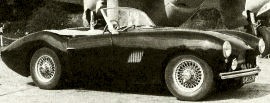 |
 |
Allard Palm Beach Mark II XK Sports |
| |
Also see: Allard Road Tests and Reviews |
| |
The Allard Palm Beach Mark II XK Sports model had the same wheelbase and track as the Mark I but featured an entirely new two-seat aluminium-panelled body and either 3442-cc 190-bhp Jaguar or the new 2553-cc 90-bhp Ford Zephyr Zodiac engine. The traditional Allard divided-tront-axle design was dropped in favour of an unusual system of lower wishbone and upper sliding bush, combined with laminated torsion bars. |
|
 |
 |
 |
Allard J3R |
| |
Also see: Allard Road Tests and Reviews |
| |
The Allard J3R was intended primarily for competition work. Far from underpowered, it featured a 5420-cc V8 engine, although alternative American engines could be used in the lightweight aluminium 2-seater body - which connformed to International Sports Car Regulations. The wheelbase was 8 ft. |
|
 |
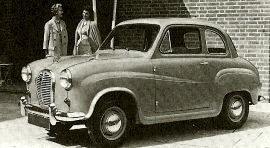 |
 |
Austin A35 Saloon and Countryman |
| |
Also see: Austin Road Tests and Reviews |
| |
The Austin A35 Saloon was an uprated successor to the popular A30, powered by a 948-cc 34-bhp engine - achieved by increasing the cylinder bore size and the compression ratio-and was distinguished from the A30 by a larger rear window, heavy chrome surround to the radiator grille and flashing traffiicators. Available in standard and de luxe Saloon, and Countryman. |
|
 |
 |
 |
Austin A55 Cambridge Saloon Model HS6 |
| |
Also see: Austin Road Tests and Reviews |
| |
The Austin A55 Cambridge Saloon, Model HS6, replaced the A50 (HS5) early in December 1956. Differences included a more pronounced chrome radiator grille surround, chrome headlamp cowls, curved chrome flash on body sides, extended rear wing-line (length increased by some 4 in), larger boot and larger rear window. A higher compression ratio, smaller wheels and the availability of either overdrive or a Manumatic clutch had been previously introduced on the A50 in the autumn of 1956. The A40 Cambridge (GS5) was dropped. |
|
 |
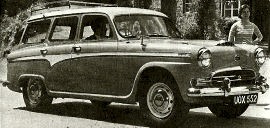 |
 |
Austin A95 Westminster |
| |
Also see: Austin Road Tests and Reviews |
| |
The Austin A95 Westminster was the 1957 replacement for the 1954-56 A90. Available with Saloon (BS6) and Countryman estate car (BW6, shown) bodywork, it had more engine power (92 v. 85 bhp), a slightly longer wheelbase and a restyled body which included modified frontal treatment, a larger rear window, bodyside flashes and a squared-off rear wing line. Automatic transmission was available. |
|
 |
 |
 |
Austin A135 Princess Mark IV Models DS7 and DM7 Saloon and Limousine |
| |
Also see: Austin Road Tests and Reviews |
| |
The Austin A135 Princess Mark IV Models DS7 and DM7 Saloon and Limousine featured a new steel-and-alloy streamlined Vanden PI as body on a new X-braced chassis frame, power-steering, vacuum-servo brakes and automatic transmission as standard. The six-cylinder 3·9-litre engine had twin carburettors and developed 150 bhp at 4100 rpm. From August 1957 known as Princess. |
|
 |
 |
 |
Austin Model FL1 Hire Car |
| |
Also see: Austin Road Tests and Reviews |
| |
The Austin Model FL1 Hire Car was in production from 1948/49 and from November 1954 was available with a diesel engine (Model FL 1 D). It was a modiification of the contemporary Model FX3 Taxi (and FX3D diesel from August 1954) All had 9 ft 2 in wheelbase, Girling mechanical brakes and four fitted Smith hydraulic jacks In 1959 they were replaced by restyled models. |
|
 |
 |
 |
|
| |
Also see: Austin Healey Road Tests and Reviews |
| |
The Austin-Healey 100 Six (Model BN4) Sports Tourer was a new model, introduced in August 1956 and powered by a 2639-cc six-cylinder twin-carburettor engine which developed 102 bhp at 4600 rpm. The revised-longer-body featured occasional rear seats for children, resulting in rather less luggage space, a wide mesh radiator grille, bonnet top air vent a fixed windscreen and a semi-rigid tonneau cover, designed to protect the rear seats when not in use. The four-cylinder 100 model was discontinued in late 1956. During 1958-59 the 100 Six was produced also by MG. |
|
 |
 |
 |
Bentley S-Series Saloon |
| |
Also see: Bentley Road Tests and Reviews |
| |
Shown is a two-door model, bodied by James Young of Bromley, and constructed from steel and light-alloy with aluminium panelling. The Continental chassis were continued with a number of mechanical changes including increased engine power-larger carburettors and inlet valves, and a raised compression ratio. |
|
 |
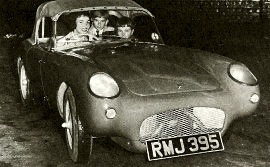 |
 |
Berkeley Sports |
| |
|
| |
The Berkeley Sports was aunched following countrywide publicity, this ingenious front-wheel drive miniature sports car featured body and main chassis components moulded in fibreglass, strengthened with light alloy sheet a two-cylinder two-stroke air-cooJed Anzani 322-cc engine and a three-speed gearbox. The engine was later superseded by a two-cylinder 328-cc Excelsior unit. Although basically a twooseater, it had a detachable panel which concealed space for two small children or extra luggage behind the front seats. A detachable hard-top was optionally available. The Berkeley was built by an established caravan manufacturer. |
|
 |
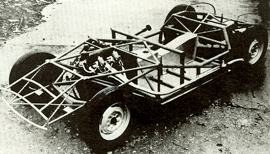 |
 |
Buckler DD2 |
| |
|
| |
The Buckler Car company was founded by Derek Buckler and was based in Reading, Berkshire, England. It manufactured approximately 500 cars between 1947 and 1962. The Company made many of its cars in Crowthorne , Berkshire and a plaque can be seen on the site of the former factory. The company was unusual in featuring spaceframe construction, and the high quality cars were supplied either fully built to order with a works body or optionally and mostly in component form for home completion.
They were designed to accept a range of mechanical components to enable buyers to create a lightweight sports car suitable for road use and in rallies, trials, speed hillclimbs or racing. The first model, based on Derek Buckler's own very successful 1947 Buckler Special, was called the Mark V, allegedly because he did not want people to think it was the first car. After prolific success in the early and mid-1950s, Buckler's popularity waned during the later 1950s as other manufacturers came on the scene and when the kit-car market suffered a reversal in the early 1960s.
However Bucklers had considerable success entering the new Kart market in the 1960s but the founder had to sell his company as a going concern circa 1962 due to failing health. After that time the company seemed to lose momentum and the new owners closed down after a few years of spasmodic trading. Derek Buckler who had been in poor health for some time, died in 1964. As well as making cars, Buckler made gear sets for other companies including Lotus Cars. They also built the first racing car chassis for the Brabham MRD. The DD2 pictured was manufactured between 1957 and 1962. |
|
 |
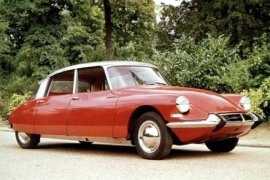 |
 |
Citroen DS |
| |
Also see: Citroen Road Tests and Reviews | Citroen Brochures |
| |
The DS's unique hydraulic suspension cemented Citroen's reputation as a maker of comfortable cars, but its unusual, sleek profile made it a style leader from day one. |
|
 |
 |
 |
Fiat 500 |
| |
Also see: Fiat Road Tests and Reviews | Fiat Brochures |
| |
The 500's brief was simple. FIAT bosses wanted a practical and affordable-for-the-masses four-seat car. The resulting machine became the Italians' 2CV, and a credible runabout even today. |
|
 |
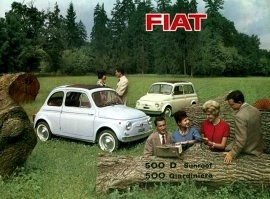 |
|
 |
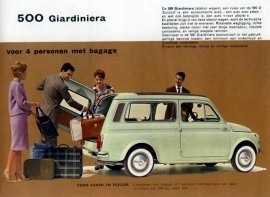 |
|
 |
 |
|
 |
 |
|
 |
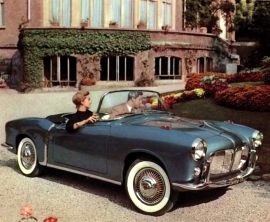 |
|
 |
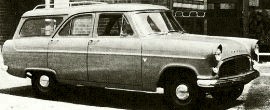 |
 |
Ford Consul and Zephyr Mark II Farnham Estate |
| |
Also see: Ford UK Road Tests and Reviews |
| |
The Ford Consul and Zephyr Mark II Farnham Estate Cars were conversions of the respective saloon models by E. D. Abbott Ltd of Farnham, which involved extending the roof line horizontally and fitting two additional side windows and a curved window in a single rear door. Other Zephyr and Consul models were continued without material changes. Automatic transmission became optionally available on the Zephyr and Zephyr Zodiac. |
|
 |
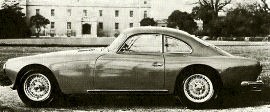 |
 |
Frazer-Nash Continental Gran Turismo Coupe |
| |
|
| |
The Frazer-Nash Continental Gran Turismo Coupe was introduced in the autumn of 1956 (chassis), this powerful two-seater featured a low purposeful-looking body (introduced 1957), and was powered, initially, by a BMW 2430-cc V8 engine, a 2580 cc unit became standard later in 1957. Alternative bodies were available. |
|
 |
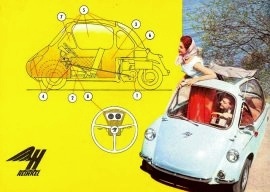 |
|
 |
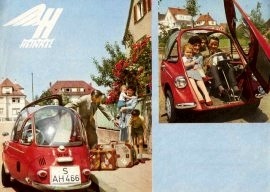 |
|
 |
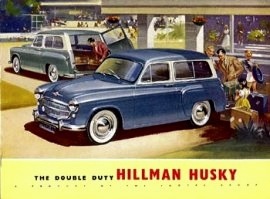 |
|
 |
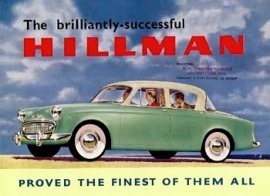 |
|
 |
 |
 |
Hillman Minx Series I Estate |
| |
Also see: Hillman Road Tests and Reviews |
| |
The Hillman Minx Series I Estate was a steel-bodied, four-door model, introduced in June 1957 and similar to the Minx Series I Saloon, both mechanically and with regard to its front end styling. Wheelbase was 8 ft. The other Minx models had featured this styling from mid-1956 and were continued without material changes. All had a 1390-cc 'square' (76·2 x 76·2 mm bore and stroke) OHV Four engine. |
|
 |
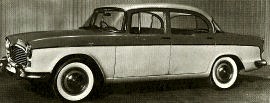 |
 |
Humber Hawk Saloon Series I - Humber New Hawk |
| |
Also see: Humber Road Tests and Reviews |
| |
The Humber Hawk Saloon, Series I version was introduced in the spring of 1957. It featured a completely new low and flush-sided body with a wide radiator grille, cowled headlamps, a large boot and a wraparound windscreen and rear window. The four-cylinder 2267-cc engine developed 73 bhp (net) at 4400 rpm. A Touring Limousine was also available. Initially the Hawk Series I models were called 'New Hawk', although this name never appeared on the cars. |
|
 |
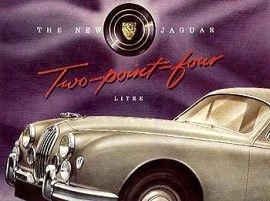 |
|
 |
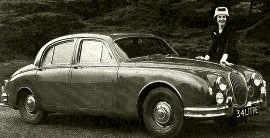 |
 |
Jaguar Mark I 3·4-Litre Saloon |
| |
Also see: Jaguar Car Reviews and History - Swallow Sidecars |
| |
The Jaguar 3·4-Litre Saloon was introduced in January 1957, and was of similar appearance to the existing '2·4' model (see above) but had a wider radiator grille (which was later to appear on the '2·4' also) and cut-away rear wheel covers. The twin-carburettor six-cylinder 3442-cc overhead camshaft engine developed 210 bhp at 5500 rpm. Bore and stroke were 83 x 106 mm. Twin exhaust tail pipes distinguished the '3·4' from the smaller-engined model at the rear. overdrive or automatic transmission were available at extra cost. The car had a maximum speed of 120 mph and a fuel consumption range of 18-27 mpg. Dunlop disc brakes and wire spoke wheels were offered as optional extras from October. In late 1959 a revised model was launched, designated the "Series 2". |
|
 |
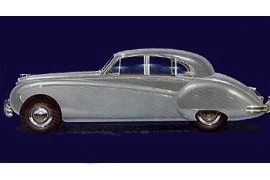 |
 |
Jaguar Mark VII |
| |
Also see: Jaguar Road Tests and Reviews |
| |
The Jaguar Mark VIII Saloon succeeded the Mark VII M, which it resembled apart from the following features: one-piece windscreen, two-tone paint finish divided by chrome beading, radiator grille with wider chrome surround and twin exhausts. The 3A-litre engine had a new cylinder head, induction system and carburettors. The Mark VII M continued to be available to special order. |
|
 |
 |
 |
|
| |
Also see: Jaguar Car Reviews and History - Swallow Sidecars |
| |
The Jaguar Mark VIII Saloon succeeded the Mark VII M, which it resembled apart from the following features: one-piece windscreen, two-tone paint finish divided by chrome beading, radiator grille with wider chrome surround and twin exhausts. The 3·4-litre engine had a new cylinder head, induction system and carburettors. The Mark VII M continued to be available to special order (see above). |
|
 |
 |
 |
|
| |
Also see: Jaguar Car Reviews and Jaguar - A Racing Pedigree |
| |
The Jaguar XK150 Drophead Coupe appeared in May 1957. Wider and roomier bodied than the preceding XK140 (1954-57) and XK120 (1948-54) this even more powerful model featured a wider radiator grille with more slats, a one-piece curved windscreen, a straightened wing line, revised instrumentation, a wider interior and higher door handles. Servo-assisted disc brakes were optionally available The twin-OHC 3-4-litre (83 x 106 mm) engine produced 210 bhp at 5500 rpm.
The XK150 was available also as a Fixed-Head Coupe and, from 1958, as a Roadster. From October 1959 all models could be supplied with the 3·8-litre (87 x 106 mm) engine, at extra cost. In 1961 all models were discontinued and superseded by the entirely new E-Type Open Two-seater and Fixed-Head Coupe, both with 3·8-litre engine and 8 ft (v. 8 ft 6 in) wheelbase. |
|
 |
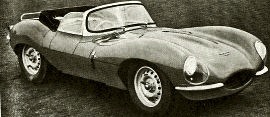 |
 |
Jaguar XK SS Super Sports |
| |
Also see: Jaguar Car Reviews and History - Swallow Sidecars |
| |
The Jaguar XK SS (Super Sports) was a race-bred fully road-equipped version of the highly successful D-type. Its life span was shortened as a result of a fire that destroyed part of the Jaguar factory and with it twelve completed cars and all the jigs and tools. Of the small number produced, most were exported. |
|
 |
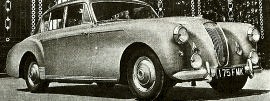 |
 |
Lagonda Series II Saloon |
| |
Also see: Lost Marques - Lagonda |
| |
The Lagonda Series II Saloon had detail changes (to its all-independently sprung four-door luxury model) which included small mechanical modifications and the addition of a number of coachwork items. Production was discontinued in January 1958 - the final chassis No. being LB.290/1/267. |
|
 |
 |
|
 |
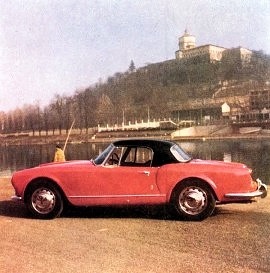 |
|
 |
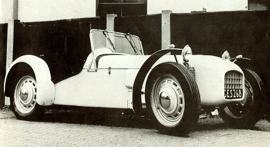 |
 |
Lotus Mark VI |
| |
Also see: Lotus Road Tests and Reviews | Lotus Brochures |
| |
The Lotus Mark VI in many ways reflected Chapman's background in engineering: his designs resulted from a stress analysis of loads into the frame, they were extremely light (the 6' space frame weighed only 55 lbs/25 kg), and the suspension incorporated the latest advances. The prototype chassis was built up by the Progress Chassis Company and the aluminium body was constructed by panel beaters Williams and Prichard. (Both firms would later furnish bodies and chassis for subsequent models.)
The cheap and easily available mechanical parts were sourced from the Ford Prefect. The Mark VI became a popular sight on Britain's racetracks, and was a frequent winner, beating many more powerful and expensive cars, earning praise for very good handling and superior low-speed acceleration. An important facet of the success of the kit was Chapman's offering a comprehensive package in the Mark VI, including most of the special parts needed, and not just the chassis.
The Mark VI chassis came with mounting points for several different engines including the 1172cc (71.5ci) Ford 10, the 1250 cc or 1500 cc MG TF, the 1500cc (92ci) Consul, and the exalted Coventry Climax. Standardized as far as possible for volume production, some units were customized per the owners wishes. Lotus even modified the owner's parts, if needed. The success of the Mark VI in competition and sales (100 built by 1955) established Chapman as a manufacturer of specialty cars. |
|
 |
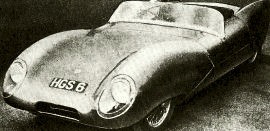 |
|
 |
 |
 |
|
| |
Also see: Austin Road Tests and Reviews |
| |
After selling so well in the United States for over three years, the Metropolitan 1500 became available to the British home market as Hard-top (Model HE6) and Convertible (MIodel HD6). The Metropolitan was originally designed by Nash in the USA and from 1954 was built in Britain by Austin in connnction with Fisher & Ludlow. Early models had a 1200-cc Austin Engine. During 1954-1956 it earned over 35 million dollars and for some time it was the best-selling British-built car in the USA. |
|
 |
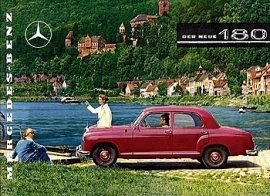 |
|
 |
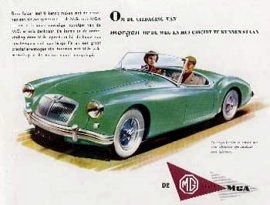 |
 |
|
| |
Also see: MG Road Tests and Reviews | MG Brochures |
| |
The MGA Hard-top Coupe was an addition to the popular open modeI which continued with slight modifications to the hood in the form added quarter lights; a detachable hard-top was optionally available. The output of the 1489-cc engine was increased fram 68 to 72 bhp. |
|
 |
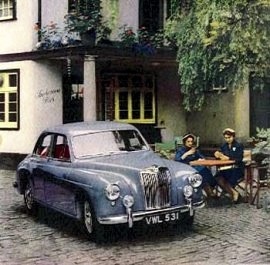 |
 |
MG Magnette ZB Saloon |
| |
Also see: MG Road Tests and Reviews | MG Brochures |
| |
The MG Magnette ZB Saloon replaced the ZA model which was discontinued in the summer of 1956. Modifications included a straight chrome strip on the body sides and a parcel shelf below the facia. "Manumatic" two-pedal control was optional and a new variant was introduced, called the Magnette Varitone, with wraparound rear window and two-colour paint finish, divided by a chrome strip. |
|
 |
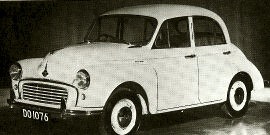 |
 |
Morris Minor 1000 Saloon |
| |
Also see: Morris Road Tests and Reviews |
| |
The Morris Minor 1000 Saloon was a replacement for the 1948-56 Minor Saloon. This more powerful version featured a 948-cc 37-bhp engine, c1ose- ratio gearbox with sports type remote-control change, and a higher rear axle ratio. The appearance was changed by the introduction of a large one-piece curved windscreen and matching rear window. and the interior improved by the fitting of lidded facia glove boxes and a deeply dished steering wheel. |
|
 |
 |
 |
Morris Cowley 1500 Saloon |
| |
Also see: Morris Road Tests and Reviews |
| |
The Morris Cowley 1500 Saloon was uprated by the adoption of the 1489-cc 55-bhp B-Series Oxford engine. It was distinguished from the preceding 1200 version by restyled bonnet and rear wings, redesigned facia and a dished steering wheel, but remained slightly less well equipped and thus cheaper than the Oxford, which was similar in overrall dimensions. |
|
 |
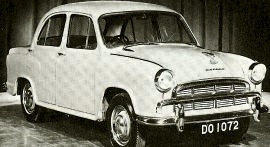 |
 |
Morris Oxford Series III Saloon |
| |
Also see: Morris Road Tests and Reviews |
| |
The Morris Oxford Series III Saloon featured revised body lines and fittings, modified interior and increased engine power as a result of raising the compression ratio from 7·15 to 8·3:1. "Manumatic" two-pedal control was available on the Saloon but not on the Traveller estate car. |
|
 |
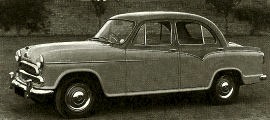 |
 |
Morris Isis Series II Saloon |
| |
Also see: Morris Road Tests and Reviews |
| |
Top of the Morris range, the six-cylinder Morris Isis Series II Saloon featured among its list of modifications a restyled bonnet with curved fluting - as on the Cowley and Oxford - restyled rear wings and lights, a mesh grille, added brightwork, revised interior and a floor-mounted gear-change. Automatic transmission was optional. |
|
 |
 |
 |
Morris Isis Traveller |
| |
Also see: Morris Road Tests and Reviews |
| |
A Morris Isis Traveller version with 65 cubic feet of luggage space was also offered for 1957. The Saloon was discontinued early in 1958, the Traveller in September 1957. |
|
 |
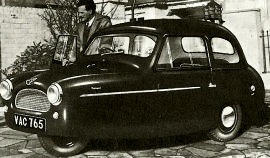 |
 |
Reliant Regal Mark III |
| |
Also see: Reliant Road Tests and Reviews |
| |
The Reliant Regal Mark III four-seater three-wheeler differed from the firm's Regal Mark II by a restyled (fibreglass) body which was longer and wider. with a higher waistline and wider doors. It also had rounded front wings with a lower bonnet and an oval grille. and flush streammlined rear wings. Wheelbase was 6 ft 2 in. A Drophead Coupe was also available The engine was a 747'5-cc 16-bhp side-valve Four. |
|
 |
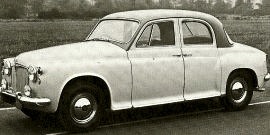 |
 |
Rover 105S and 105R Saloons |
| |
Also see: Rover Road Tests and Reviews | Rover Brochures |
| |
The Rover 105S and 105R Saloons were additions to the P4 range and featured a twin-carb version of the 2638-cc '90' engine. The 105R had "Roverdrive" automatic transmission with built-in automatic overdrive; the 105S had a synchromesh gearbox with automatic overdrive. The body was as on the 75 model with bench seats; De Luxe versions had bucket seats. The 60, 75 and 90 P4 models were continued with a number of modifiications including extended front wings with flashing trafficator at the tip. |
|
 |
 |
|
 |
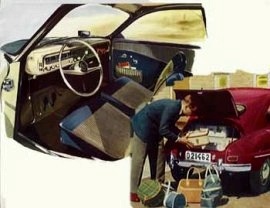 |
|
 |
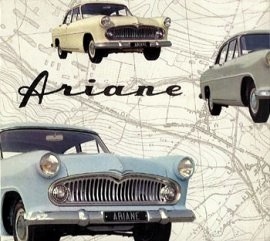 |
|
 |
 |
|
 |
 |
 |
Singer Gazelle Saloon |
| |
Also see: Singer Road Tests and Reviews |
| |
Following the take-over of the Singer company by the Rootes Group, production of the Singer Gazelle Saloon four-door model (Series I) got underway late in 1956. Based on the Hillman Minx it featured an oval radiator grille and distinctive colour schemes to distinguish it externally, and walnut veneer and leather upholstery to give interior distinction. The car featured a raised compression ratio version of the 1497-cc Singer engine. A two-door Convertible model was also available. |
|
 |
 |
 |
Standard Eight Gold Star Saloon |
| |
Also see: Standard Road Tests and Reviews |
| |
The Standard Eight Gold Star Saloon featured a shaped mesh radiator grille, raised compression ratio (8·25:1), external luggage boot opening and improved interior trim. The Super Saloon and Family Saloon Phase II were both discontinued. A Ten Gold Star Saloon likewise replaced the Ten Family Saloon and the Ten Companion; the Family Companion Estate Car was also discontinued. |
|
 |
 |
|
 |
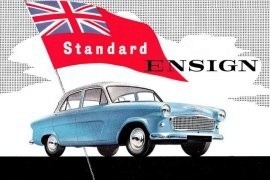 |
|
 |
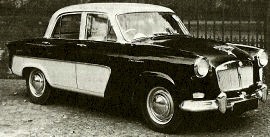 |
 |
Standard Sportsman Saloon |
| |
Also see: Standard Road Tests and Reviews |
| |
The Standard Sportsman Saloon was externally distinguished from the Vanguard Phase III Saloon by two-colour paintwork as standard, an oblong radiator grille of vertical bars with a thick bar in the centre, dual sidelights with flashing trafficators below and additional brightwork. The twin-carburettor high-compression version of the 2088-cc engine developed 90 bhp at 4500 rpm. overdrive was standard. |
|
 |
 |
 |
Standard Vanguard Phase III Estate |
| |
Also see: Standard Road Tests and Reviews |
| |
The Standard Vanguard Phase III Estate had similar frontal appearance to the Phase III Saloon but with a longer body and upper and lower tailgates. Wheelbase was 8 ft 6 in. De Luxe versions of both were also introduced late in 1956 - with hooded headlamps, chrome body side mouldings and bigger brakes. |
|
 |
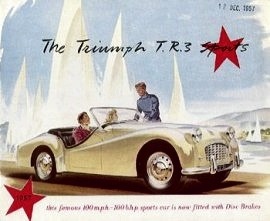 |
|
 |
 |
 |
Turner 950 Sports |
| |
|
| |
The Turner 950 Sports was a larger-engined replacement for the 803 model. Its 948-cc Austin A35 power unit developed 34 bhp (40 bhp on later versions). Other improvements included hydraulic rear brakes, hydraulically operated clutch and the addition of an ammeter and a water temperature gauge. The car was claimed to be good for 45-50 mpg and 90 mph. |
|
 |
 |
 |
Unicar Saloon |
| |
|
| |
The Unicar Saloon was a plastics-based rear-engined ultra-light economy car introduced by S. E. Opperman Ltd of Boreham Wood, Herts, in the autumn of 1956. It featured a two-door body with seating for two adults and two children, an Anzani 322-cc twin-cylinder two-stroke engine, and a three-speed gearbox. The car was only 9 ft 6 in long and sold at just under £400. |
|
 |
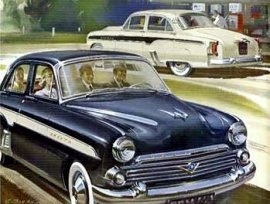 |
|
 |
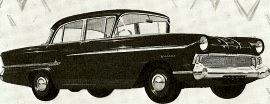 |
 |
Vauxhall Victor Saloon Series F |
| |
Also see: Vauxhall Road Tests and Reviews |
| |
The Vauxhall Victor Saloon, Series F, was introduced early in 1957 to replace the Wyvern Series EIX. Prototypes had been built since 1953. The Victor was available in two versions (Standard, Model FS, and Super, Model FD) and featured a completely new body with panoramic windscreen. vertical windscreen pillars, wraparound rear window, rectangular mesh radiator grille and traditional Vauxhall flutes along the sides. The 1507-cc four-cylinder power unit developed 54·8 bhp at 4200 rpm. Wheelbase was 8 ft 2 in. Hooded headlamp rims were added in the summer of 1957. |
|
 |
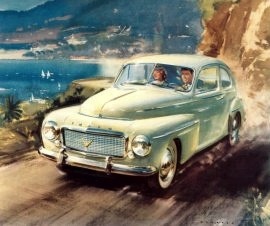 |
 |
|
| |
Also see: Volvo Road Tests and Reviews |
| |
While the PV444 was easy for anyone to drive, the skilled motorist got, in addition to high performance, great satisfaction for the way in which that prowess was achieved. No doubt a model for the Volvo enthusiasts only, don't be too quick to dismiss the car should you chance across it at a motor show. In their day, they offered almost unrivaled quality and much better than average performance. |
|
 |
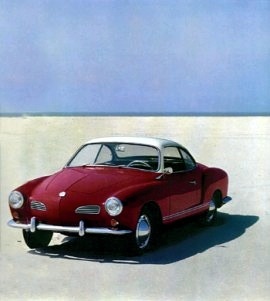 |
|
 |
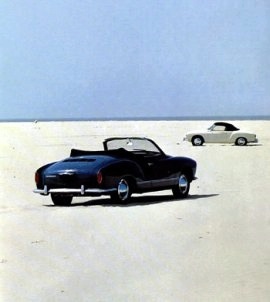 |
|
 |
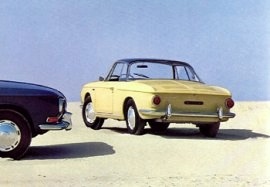 |
|
 |
 |
 |
Wolseley 15/50 |
| |
Also see: Wolseley Road Tests and Reviews |
| |
Quoting the brochure: "In the Fifteen-Fifty, beauty is far from skin-deep. The whole problem of designing a capacious four-seater car with ample luggage space, that has not only good line, but is functionally efficient in every way, is one of great complexity. The design and co-relation of every component in the Fifteen-Fifty has been so handled that the ultimate shape is one of excellent "wind-cheating" form. Wolseley engineers have proved, after exhaustive trials, that the Fifteen-Fifty body form pays dividends in terms of better petrol consumption, better acceleration and reduced wind noise at high speed. Transmission is primarily via a Borg and Beck single-plate dry clutch to a four-speed gearbox with synchromesh. on the three higher ratios. Gear change is direct by a short centrally mounted lever." |
|
 |
 |
 |
Wolseley 1500 |
| |
Also see: Wolseley Road Tests and Reviews |
| |
The Wolseley 1500 Saloon was a completely new model, with only the traditional radiator grille and illuminated maker's badge identifying it as a Wolseley. The neat four-door body featured two-colour paintwork and distinctive body side-flashes. The use of mechanical components common to other Nuffield models played a big part in making the price extremely attractive for a car in this class - £759 incl. tax. The 1½-litre engine was from the Morris Oxford, but with a slightly reduced compression ratio, and the suspension system was based on that of the Morris Minor. |
|
 |
 |
 |
Wolseley 1500 |
| |
Also see: Wolseley Road Tests and Reviews |
| |
Quoting the brochure: "Beautifully styled. Realistically priced. Brilliantly engineered. This new Wolseley Fifteen Hundred. It is a compact car with high performance. The 1500 c.c. o.h.v. engine provides a high power-to-weight ratio giving 'overdrive performance' on a normal, though high, top gear for long-distance tireless motoring. Speed in third nears that - in top - overtaking is swift and sure. Brakes are large and powerful. Torsion bar front suspension, allied to good steering geometry gives rock-steady road-holding and cornering. All interior appointments are tastefully styled to tone with the gay, hard-wearing exterior colours. This new Wolseley is built for to-day's motoring conditions, for those who want all the advantages of Wolseley quality and craftsmanship at a favourable price. Prove it for yourself!" |
|
 |
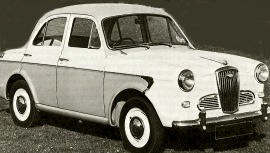 |
 |
Wolseley 1500 |
| |
Also see: Wolseley Road Tests and Reviews |
| |
The Wolseley Six-Ninety Series III appeared in May 1957 and replaced the Series II version, which had only been in production for about six months. The car, which was available only in four-door Saloon form, was distinguishable from the previous version by a wider curved rear window. It also featured high-stability servo-assisted brakes. The Fifteen-Fifty was continued with minor modifications. |
|
 |
 |
|
 |
 1957 Volkswagen Type S06 Insulated Van.
1957 Volkswagen Type S06 Insulated Van. |
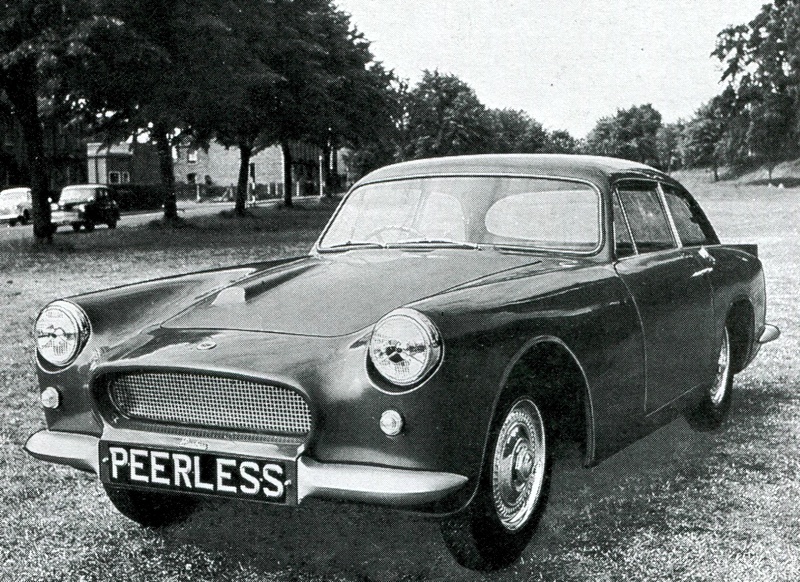 The Peerless GT was anounced in August, 1957. It had a standard TR3 engine in a light tubular space-frame with an aluminium body and plastic moulded parts inside. The Peerless weighed less than 2000 pounds, and could do 110 mph flat out. It was recorded as slower than a TR to 70 but faster to 90 and faster over the standing quarter mile, thanks to the coupe body having less drag. It held the road better than a TR (de Dion rear suspension) and, from June 1958, had a fibre-glass body. But the company had bitten off more than it could chew. In 1959 it re-organised, but was still too small for the job it had taken on. The Peerless earned a reputation for squeaks and rattles, as it was poorly assembled and finished. The company aimed to produce 25 cars a week by 1960, but in February, 1960, it filed for bankruptcy. They tried again later that year, with an improved version named the Warwick. It was lighter, stronger and better-finished, with the same good road-holding. Five cars a week was the aim, but sales were no better this time and in a few months the company went under for the third and last time.
The Peerless GT was anounced in August, 1957. It had a standard TR3 engine in a light tubular space-frame with an aluminium body and plastic moulded parts inside. The Peerless weighed less than 2000 pounds, and could do 110 mph flat out. It was recorded as slower than a TR to 70 but faster to 90 and faster over the standing quarter mile, thanks to the coupe body having less drag. It held the road better than a TR (de Dion rear suspension) and, from June 1958, had a fibre-glass body. But the company had bitten off more than it could chew. In 1959 it re-organised, but was still too small for the job it had taken on. The Peerless earned a reputation for squeaks and rattles, as it was poorly assembled and finished. The company aimed to produce 25 cars a week by 1960, but in February, 1960, it filed for bankruptcy. They tried again later that year, with an improved version named the Warwick. It was lighter, stronger and better-finished, with the same good road-holding. Five cars a week was the aim, but sales were no better this time and in a few months the company went under for the third and last time. |
|
|
Sell Your Car or Parts
Browse the Classifieds
It's Absolutely Free! - Find Out More
|



